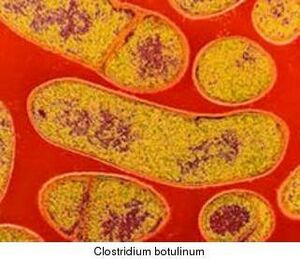Botulism
Original Editors - Elliot Mattingly from Bellarmine University's Pathophysiology of Complex Patient Problems project.
Top Contributors - Elliot Mattingly, Lucinda hampton, Admin, Elaine Lonnemann, Wendy Walker, WikiSysop and Kim Jackson
Introduction[edit | edit source]
Botulism is a neuroparalytic syndrome that results from the systemic effects of an exo neurotoxin produced by the spore-forming, anaerobic bacterium Clostridium botulinum.[1]
- Botulinum toxins are extremely lethal with the ability to block nerve functions, potentially leading to respiratory and muscular paralysis.
- Human classifications include: food borne botulism; infant botulism; wound botulism; inhalation botulism.
- Food borne botulism often is caused by ingestion of home canned, preserved or fermented foodstuffs.[2]
Watch this 3 minute video on Botulism- what it is and how it could kill you.
Etiology[edit | edit source]
Botulinum toxins are neurotoxic, affecting the nervous system. Botulinum neurotoxin is considered the deadliest toxin known due to its high potency and lethality, with a lethal dose of 1 ng to 3 nanograms of toxin per kilogram of body mass. The flaccid paralysis of botulism results from the irreversible inhibition of acetylcholine release at the presynaptic nerve terminal of the neuromuscular junctions.[1]
Spores produced by the bacteria Clostridium botulinum (being heat-resistant and found widely in the environment) freely germinate, grow and then excrete toxins in anaerobic conditions..[2]
Transmission: There are three common forms of botulism.
- Intestinal botulism (most common form). Caused by eating food, or swallowing dust or soil that contains the bacteria, Clostridium botulinum. Infants under the age of 12 months are most at risk and adults who have reduced gastrointestinal immunity. The bacteria multiply inside the gut and produce toxins. Healthy adults have natural defences in their gut that prevent the bacteria from multiplying usually.
- Food-borne botulism: Caused by eating food contaminated with toxins. Symptoms generally occur between 12 and 36 hours after eating the contaminated food. This form of botulism can be severe and may lead to death.
- Wound botulism (rare form): Caused by bacteria (often in soil or gravel) entering the body through a wound or IV drug use. Symptoms can occur up to two weeks after the wound.
Epidemiolgy[edit | edit source]
- In 2014, 123 cases of botulism were reported by 16 EU/EEA countries, including 91 cases reported as confirmed. Thirteen countries notified zero cases.[4]
- In Australia, there is typically only one case of botulism reported per year.[5]
- In the United states, 5 years from 2011 through 2015, an average of 162 annual cases of botulism was reported.[1]
'Botox'[edit | edit source]
C. botulinum is the bacterium used to produce Botox, a product predominantly injected for clinical and cosmetic use (a purified and heavily diluted botulinum neurotoxin type A). [2]
Characteristics/Clinical Presentation[edit | edit source]
Classic early botulism signs are cranial nerve palsies , progressing to the symmetrical descending weakness of the torso, limbs, and smooth muscle and eventual paralysis. Patients generally experience diplopia, dysphagia, dysphonia, and dysarthria. Diaphragm involvement triggers respiratory failure.
- Paralysis of autonomic smooth muscle leads to constipation and urinary retention. Those with food-borne botulism presenting often with a prodrome of abdominal pain, nausea, and vomiting beginning day 1 to day 3 after ingestion of toxin.
- Infant Botulism has a variable presentation attributable to varying inoculum sizes, host vunerability, and time to presentation. Early symptoms involving constipation, weakness, feeding difficulties, weak cry, and drooling, potentially progressing to global hypotonia requiring immediate intubation and mechanical ventilation.
- Wound botulism may present in people who present with cranial nerve symptoms and cellulitis following subcutaneous administration of illicit drugs, and presents with fever and infection signs. Wound botulism incubation takes 5 to 15 days from the time of spore introduction.[1]
Diagnosis[edit | edit source]
Usually based on clinical history and clinical examination followed by laboratory confirmation including demonstrating the presence of botulinum toxin in serum, stool or food, or a culture of C. botulinum from stool, wound or food.
Differental diagnosis includes: Stroke, Guillain-Barré syndrome, or myasthenia gravis.[2]
Treatment[edit | edit source]
The only definite treatment for botulism is administrating antitoxin early, it being effective if given before botulism symptoms are obvious. Once symptoms appear, 75% of patients require long-term artificial ventilation for survival[6], with severe botulism cases needing supportive treatment, especially mechanical ventilation (may be required for weeks or even months). Antibiotics are not required (excepting wound botulism). A botulism vaccine exists but it effectiveness has not been fully evaluated and it has harmful side effects.[2]
Physical Therapy Management[edit | edit source]
Physical therapists will be a part of the supportive care team that is required for individuals with botulism. Their recovery will be dependent on the administering of the antitoxin as well as the help of the supporting staff to get the individual back to their normal selves.
- Intensive Care: Close monitoring including frequent clinical evaluation of ventilation, perfusion, and upper airway integrity, continuous pulse oximetry, spirometry, and arterial blood gas measurement. Intubation is an option for patients with upper airway problems or vital capacity of less than 30% of predicted.[1]
References[edit | edit source]
- ↑ 1.0 1.1 1.2 1.3 1.4 Jeffery IA, Karim S. Botulism. StatPearls.Available:https://www.statpearls.com/articlelibrary/viewarticle/18469/ (accessed 19.12.2022)
- ↑ 2.0 2.1 2.2 2.3 2.4 World Health Organisation Botulism Available:https://www.who.int/news-room/fact-sheets/detail/botulism (accessed 19.12.2022)
- ↑ HTME. What is Botulism? Available from: https://www.youtube.com/watch?v=rI9ysEaJzVs [last accessed 19.12.2022]
- ↑ ECDC Botulism - Annual Epidemiological Report, 2016 [2014 data]. Available:https://www.ecdc.europa.eu/en/publications-data/botulism-annual-epidemiological-report-2016-2014-data (accessed 19.12.2022)
- ↑ Queensland Government Botulism Available:http://conditions.health.qld.gov.au/HealthCondition/condition/14/33/18/Botulism (accessed 19.12.2022)
- ↑ Atrium Health Wake Forest Baptist New research shows drug used to treat neuromuscular weakness could counter botulism JULY 25, 2022 Available:https://medicalxpress.com/news/2022-07-drug-neuromuscular-weakness-counter-botulism.html (accessed 23.12.2022)







